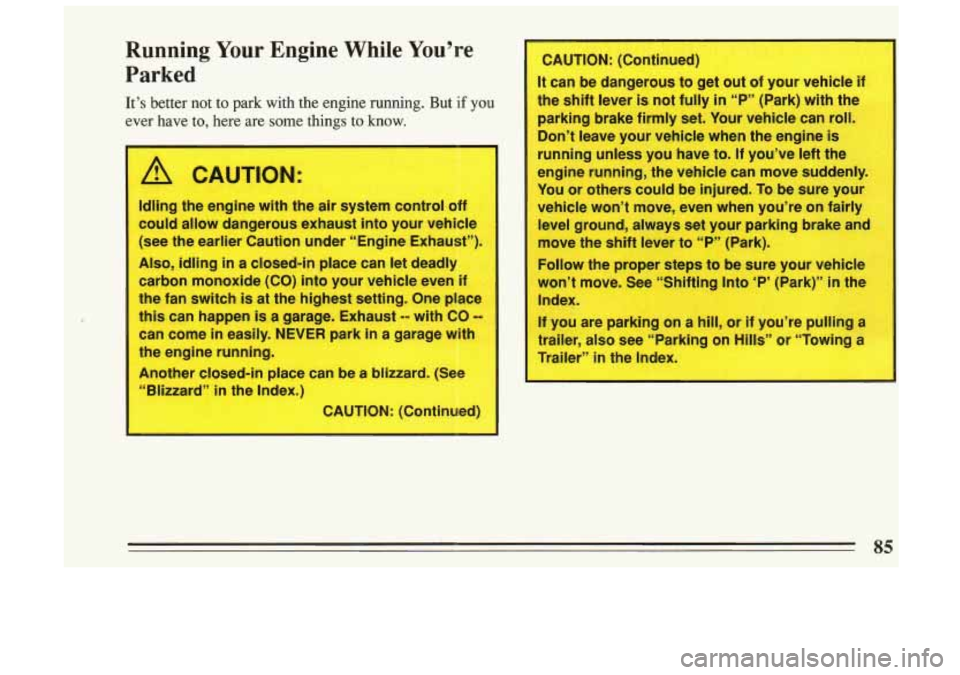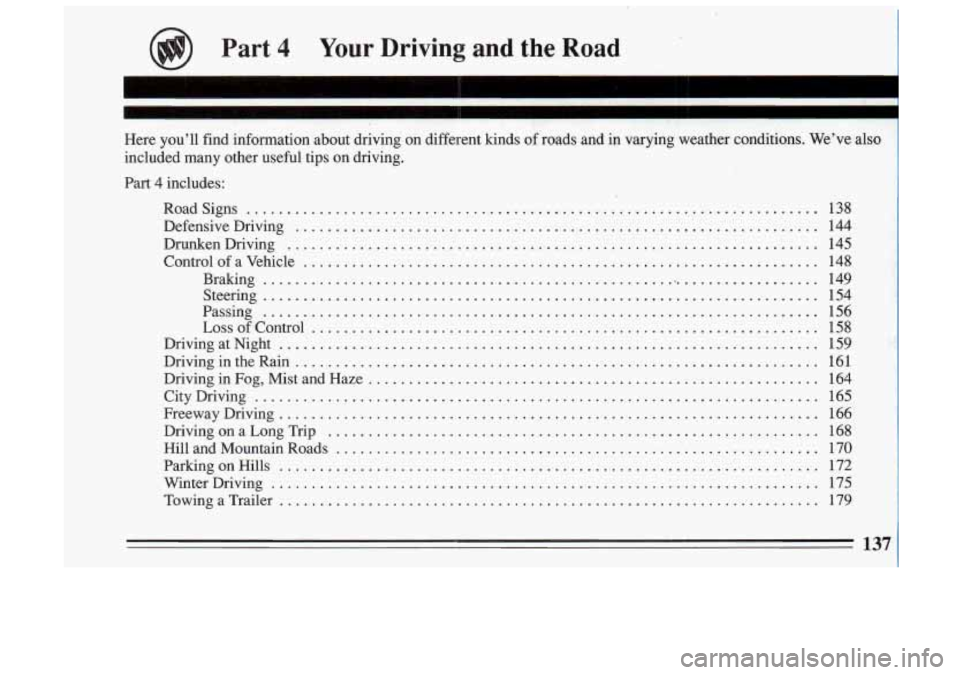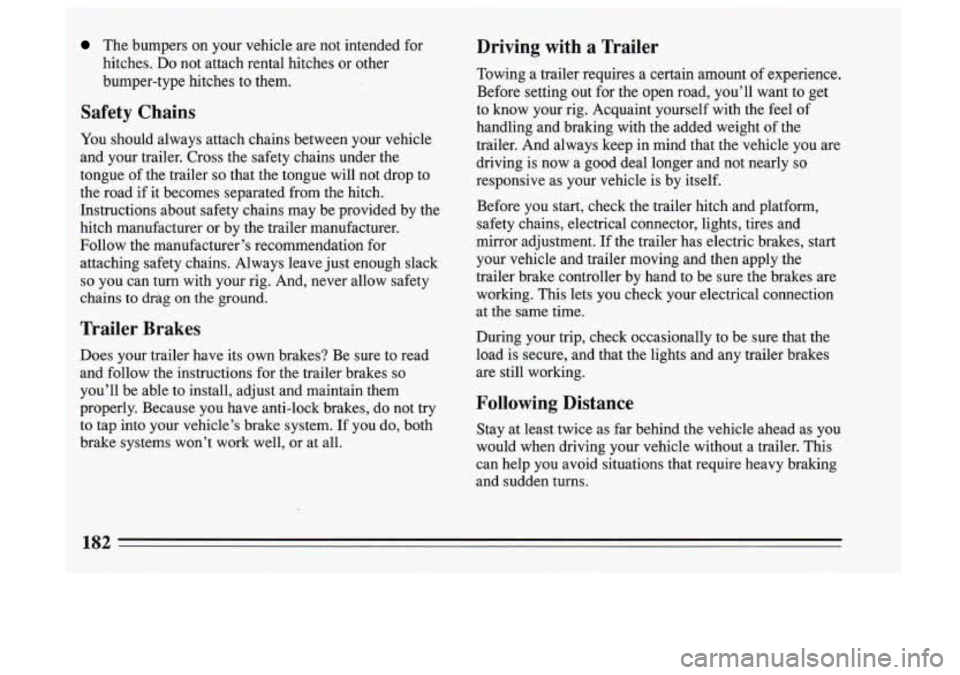1993 BUICK SKYLARK towing
[x] Cancel search: towingPage 78 of 306

Automatic Transaxle
There are several different positions for your shift lever.
P.(Park)
This locks your front wheels. It’s the best position to
use when you start your engine because your vehicle
can’t move easily.
A CAUTION:
It is dangerous to get out of your vehicle if the
shift lever
is not fully in “P” (Park) with the
parking brake firmly set. Your vehicle can
roll.
Don’t leave your vehicle when the engine is
running unless you have to. If you have left the
engine running, the vehicle can move suddenly.
You or others could be injured.
To be sure your
ehicle won’t move, when you’re on fairly level
ound, always set your parking brake and move
e shift lever to
“P” (Park). See “Shifting Into ‘P’
ark)”
in the Index. If you are parking on a hill
, if you’re pulling a trailer, also see “Parking on
11s” or “ Towing a Trailer” in the Index.
Ensure the shift lever is fully in “P” (Park) range before
starting the engine. Your Buick has a brake-transaxle
shift interlock. You have to fully apply your regular
brake before you can shift from “P” (Park) when the
ignition key is in the “Run” position.
If you cannot shift
out of
“P” (Park), ease pressure on the shift lever - push
the shift lever all the way into
“P,’ (Park) and also
release the shift lever button on floor shift console
models
- as you maintain brake application. Then move
77
Page 82 of 306

If YOU are on a hill: See “ Parking on Hills” in the Index.
That section shows how to tuk your front wheels.
If you are towing a trailer and are parking on any hill:
See
“ Towing a Trailer” in the Index. That section shows
what to do first to keep the trailer from moving.
Shifting Into 44 P 99 (Park)
I I
A CAUTION:
It can be dangerous to get out of your vehicle if
the shift lever is not fully in “PYy (Park) with the
parking brake firmly set. Your vehicle can roll.
If you have left the engine running, the vehicle
can move suddenly. You or others could be
injured. To be sure your vehicle won’t move,
when you’re on fairly level ground, use the steps
that follow.
If you are parking on a hill, or if
you’re pulling a trailer, also see “Parking On
Hills” or “Towing a Trailer”
in the Index.
Steering Column Shift Lever
1. Hold the brake pedal down with your right fuot and
2. Move the shift lever into “F”’ (Park) position like
set
the parking brake.
this:
0 Pull the lever toward you.
81
Page 86 of 306

P
-Running Your Engine While You’re
‘Parked
It’s better n.ot to park with the engine running. But if YOU
ever have to, here are~same things to how.
Idling the engine with tfie air 31 em control off
8could al~low dangerous exhaust into jour vehilcle
(see the earlier Cawtionunder “‘Engine IExhaust”:
Also, idling In a Closed-in> place can let‘ ‘dead.,
‘carbon monoxide
(CO) into yo~ur ve,hicle ewn if
t’he fan switch
is at the highest setting. One placl
this can happen is agarage. Exhaust -- with CO
can came in easily. #NEVER park in a garage with
the engine running.
Another clq3ed8-in;
place can be a blizzard. l(See
in the Index.)
nued:
It can ‘be dangerous ta get ‘olut lof ,your vehicle if
‘the shift lever is not fully
in T’ (Park) witlh trhe
parking brake flirmly set. Your vehicle
can roll.
Dm’t leave yaur vehic;le when the engine
is
running unless you have to. If you’ve lefi the
enlgine running, the vehicle can
move suddenly.
You
or others cou!ld be injured. To be sure yow’r
vehicle wonlpt move, even when
you’re on fair ~
level gramd, always set your parking brake and’
move
the shift lever to “P” (Park).
Follow the prope!r steps
to be sure your vehicle
wm’t move. See “S’hifting
Into ‘PB (Park)”’ in the
Inde?.
If
you are parking on a hill, or if you’lre pulling a
trailer,
atso see “Parking OM Hills”’ or “Towing, a
‘Trailer”
in th’e Index.
85
Page 112 of 306

This light will also come on when you set your parking
brake, and will stay on
if your parking brake doesn’t
release fully. If it stays on after your parking brake is
fully released, it means you have a brake problem.
If the
light comes on while driving, pull
off the road and stop
carefully, You may notice that the pedal is harder to
push. Or, the pedal may go closer to the floor. It may
take longer to stop. If the light is still on, have the
vehicle towed for service. (See “Towing Your
Car” in
the Index.)
-
1
I A CAUTION:
Your brake system may not be working properly
if the brake warning light is on. Driving with the
brake warning light on can lead to an accident. If
the light is still on after you’ve pulled off the road
and stopped carefl
r, have the vehicle towed for
service.
I
Anti-Lock Brake System Warning Light
ANTI.-
LOCK
With anti-lock, this light will go on unless you start your
engine and it will stay on for three .seconds. If the light
doesn’t come on, have it fixed
so it will be ready to
warn
you if there is a problem.
If the light stays on or comes on when you’re driving,
stop as soon
as possible and turn the key off. Then start
the engine to reset the system. If the light still stays on,
or comes on again while you’re driving, your Buick
needs service. Unless the regular brake system warning
light is also on, you will still have brakes, but not
anti-lock brakes. If the regular brake system warning
111
Page 138 of 306

Part 4 Your Driving and the Road
I
Here you’ll find information about driving on different kinds\
of roads and io varying weather conditions . We’ve also
included many other useful tips
on driving .
Part 4 includes:
RoadSigns
....................................................................... \
DefensiveDriving .................................................................
DrunkenDriving ..................................................................
ControlofaVehicle ................................................................
Braking ......................................................................
Steering .....................................................................
Passing .....................................................................
LossofControl ...............................................................
DrivingatNight ...................................................................
DrivingintheRain .................................................................
Driving in Fog, Mist and Haze ........................................................
CityDriving ......................................................................
FreewayDriving ...................................................................
DrivingonaLongTrip .............................................................
HillandMountainRoads ............................................................
ParkingonHills ...................................................................
WinterDriving ....................................................................
TowingaTrailer ...................................................................
138
144
145
148
149
154
156
158
159
161
164
165
166
168
170
172
175
179
Page 180 of 306

Towing a Trailer
A CAUTION:
If you don’t use the correct equipment and drive
properly, you can lose control when you pull
a
trailer. For example, if the trailer is too heavy. the
brakes may not work well
-- or even at all. Yo
and your passengers could be seriously injured.
Pull
a trailer only if you have followed all the
steps in this section.
i ~ ~, ~~ ~~
~~~ ~~ before you pull a trailer.
Your
car can tow a trailer.
To identify what the vehicle
trailering capacity is for your vehicle, you should read
the information in “Weight of the Trailer”. that appears
I later in this section. But trailering is different than just
driving your vehicle by itself. Trailering means changes
I in. handling, durability, and fuel economy. Successful,
safe trailering takes correct equipment, and it has to be
I used properly.
That’s the reason for this section. In it are many
time-tested, important trailering tips and safety rules. Many of these are important for your safety and that of
I your passengers. So please read this section carefully
Load-pulling components such as the engine, transaxle, wheel assemblies, and tires are forced to work harder
against the drag of the added weight. The engine is
greater loads, generating extra heat. What’s more, the
trailer adds considerably to wind resistance, increasing
the pulling requirements.
All of that means changes in:
ulling a trailer improper1 required to operate at relatively higher speeds and under
Do not tow a trailer if your vehicle is equipped with the
0 Handling
2.3 Liter, L4 engine. Durability
Fuel economy
179
Page 183 of 306

The bumpers on your vehicle are not intended for
hitches.
Do not attach rental hitches or other
bumper-type hitches to them.
Safety Chains
You should always attach chains between your vehicle
and. your trailer. Cross the safety chains under the
tongue of the trailer
so that the tongue will not drop to
the road if it becomes separated from the hitch.
Instructions about safety chains may be provided by the
hitch manufacturer or by the trailer manufacturer.
Follow the manufacturer’s recommendation for
attaching safety chains. Always leave just enough slack
so you can turn with your rig. And, never allow safety
chains to drag
on the ground.
Trailer Brakes
Does your trailer have its own brakes? Be sure to read
and follow the instructions for the trailer brakes
so
you’ll be able to install, adjust and maintain them
properly. Because you have anti-lock brakes, do not try
to tap into your vehicle’s brake system. ff you do, both
brake systems won’t work well, or at all.
Driving with a Trailer
Towing a trailer requires a certain amount of experience.
Before setting out for the open road, you’ll want to get
to know your rig. Acquaint yourself with the feel of
handling and braking with the added weight of the
trailer. And always keep in mind that the vehicle you are
driving is now a good deal longer and not.nearly
so
responsive as your vehicle is by itself.
Before you start, check the trailer hitch and platform,
safety chains, electrical connector, lights, tires and
mirror adjustment. If the trailer has electric brakes, start
your vehicle and trailer moving and then apply the
trailer brake controller by hand to be sure the brakes are working. This lets you check your electrical connection
at the same time.
During your trip, check occasionally to be sure that the
load
is secure, and that the lights and any trailer brakes
are still working.
Following Distance
Stay at least twice as far behind the vehicle ahead as you
would when driving your vehicle without a trailer. This
can help you avoid situations that require heavy braking
and sudden turns.
Page 184 of 306

Passing
You’ll need more passing distance up ahead when
you’re towing a trailer. And, because you’re a good deal \
longer, you’ll need to go much farther beyond the
passed vehicle before you can return to your lane.
d
Backing Up
Hold the bottom of the steering wheel with one hand.
Then, to move the trailer to the left, just move that hand
to the left. To move the trailer to the right, move your
hand to the right. Always. back up slowly and, if
possible, have someone guide you.
Making Turns
When you’re turning with a trailer, make wider turns
than normal.
Do this so your trailer won’t strike soft
shoulders, curbs, road signs, trees, or other objects.
Avoid jerky or sudden maneuvers. Signal well in
advance.
nrn Signals When Towing a Trailer
When you tow a trailer, your vehicle has to have a
different turn signal flasher and extra wiring. The green
arrows on your instrument panel will flash whenever you signal a turn or lane change. Properly hooked up, the trailer lights will also flash, telling other drivers
you’re about to turn, change lanes or stop.
When towing a trailer, the green arrows on your
instrument panel will flash for turns even if the bulbs on
the trailer are burned out. Thus, you may think drivers
behind you are seeing your signal when they are not. It’s
important to check occasionally to be sure the trailer
bulbs are still working.
Driving On Grades
Reduce speed and shift to a lower gear before you start
down a long
or steep downgrade. If you don’t shift
down, you might have to use your’brakes
so much that
they would get hot and no longer work well.
On a long uphill grade, use the highest gear. possible. If
you cannot maintain posted speeds, driving at a lower
speed may help avoid overheating your engine and
transaxle.
Parking on Hills
You really should not park your vehicle, with a trailer
attached, on a hill. If something goes wrong, your rig
could
start to move. People can be injured, and both
your vehicle and the trailer can be damaged.
183